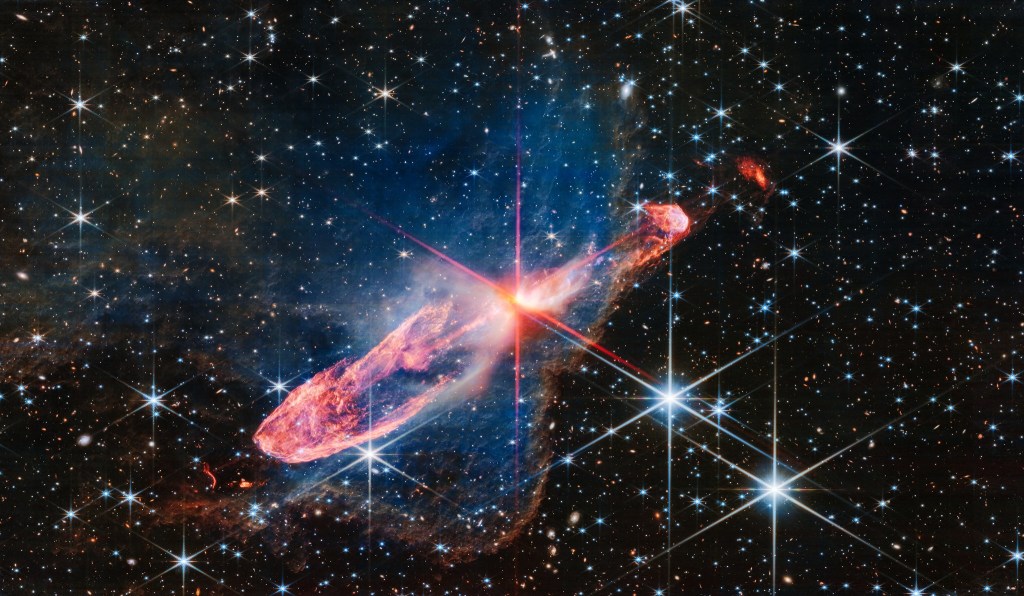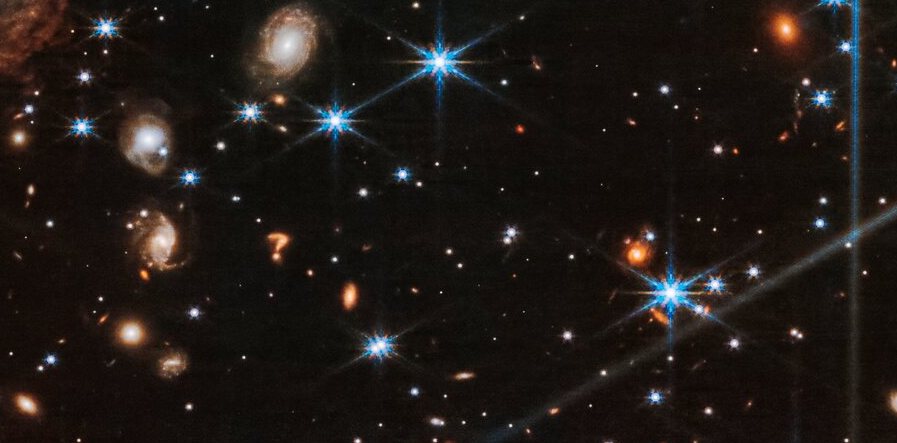On July 26 NASA’s James Webb Telescope spotted an unusual shape in the Milky Way that has raised a few questions.

In deep space, two tightly bound stars known as Herbig-Haro 46/47 are actively forming – but a cosmic question mark has stolen their thunder.
The James Webb Telescope has managed to capture the event with its NIRCam (Near-Infrared Camera), revealing in high-resolution infrared pictures that a perfect question mark had formed next to the Herbig-Haro stars.
The image is the most detailed capture of Herbig-Haro 46/47, located in the Vela Constellation around 1,470 light years from Earth.
It is a captivating scene – the plentiful stars around Herbig-Haro glisten, and swirls of gas cast beautiful hues standing out against the darkness of deep space.
And, to the bottom right of Herbig-Haro – a glowing question mark-shaped … something.
Could we be getting sent a message from a higher power, or extra-terrestrial beings?
Experts say probably not.
So what is it?
The mysterious object hasn’t been closely studied, so they can’t say definitively what it is or where it originates. Crucial clues could lie in the colour, shape and location of the cosmic question mark.

Representatives at the Space Telescope Science Institute (STCI) in Baltimore told Space.com that the question mark was likely a distant galaxy.
It may have been galaxies interacting with each other, which would explain the unique shape.
This is also potentially the first time astronomers have spotted this object, highlighting the exciting capabilities of the Webb Telescope.
Whatever it is, according to STCI, it is likely quite far from Earth, as indicated by its reddish colour.
Experts can say what it is not, though.
Matt Caplan, assistant professor of physics at Illinois State University, told CNN that the object was definitely not a star in the Milky Way, based on its shape, which lacks the tell-tale spikes or prongs of a star.
Herbig-Haro 46/47
The image which contained the question mark shape also revealed that the Herbig-Haro stars are ‘babies’, according to the Webb Telescope website.
This means Herbig-Haro is still actively forming, and the two stars are closely orbiting each other while they grow.
In the image, the baby stars themselves are basically imperceptible, concealed by a mammoth orange disk of gas and dust that will feed the stars until they are fully formed.
Astronomers have studied these two for over 6 decades now, but it wasn’t possible to view them with this level of detail until the use of the highly sensitive Webb Telescope.
The James Webb Space Telescope
The Webb Telescope has been used to follow up on the observations of the Hubble Space Telescope.
What differentiates the Webb from other NASA technology is its ability to view longer wavelengths of light than any other telescope, allowing it to see further, and in more detail.
The telescope’s capacities are so impressive that it has successfully revealed the colours of the most distant star ever detected, Earendel.
Located in the Sunrise Arc it appears to be red and, according to Nasa, is about a million times more luminous than our sun.
Tangent
This cosmic question comes amid news from a US congressional hearing in which three military veterans testified that aliens not only existed but were a common sight for pilots.
They also alleged that the US government may possess alien remains and alien aircraft, and the truth has been intentionally hidden from the public.
The Pentagon has denied these claims, and evidence is yet to be presented that supports them.
However, what is clear is that as our technology and research continue to advance, we are not going to stop being presented with bright, glowing questions from space.


